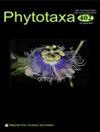埃及撒哈拉-辛迪亚特有植物区系:关键核对表、植物学分析、栖息地和植物地理分布
IF 1
4区 生物学
Q3 PLANT SCIENCES
引用次数: 0
摘要
撒哈拉-辛迪亚地区的特点是热带草原、半沙漠和热沙漠。该花卉区包括摩洛哥、毛里塔尼亚、阿尔及利亚、利比亚、埃及、巴勒斯坦、科威特、沙特阿拉伯、卡塔尔、巴林、阿拉伯联合酋长国、阿曼、也门、约旦南部、叙利亚、伊拉克、阿富汗、巴基斯坦以及信德地区。属于古热带王国的苏丹-赞比西 亚地区,以及属于全北极王国的地中海地区和伊朗-都拉斯地区,与本研究区域共享大量植物区系。本研究开始对埃及的撒哈拉-辛地亚特有植物进行研究。其目标包括评估该植物学区域内的特有植物清单,并研究以下各个方面:生命形式、栖息地、稀有形式、开花时间、扩散类型和植物地理分布。从 2020 年春季到 2023 年 9 月,共进行了 20 次实地考察,调查了埃及的不同地区。此外,还参考了以前在调查地区进行的所有研究、科学文献以及不同标本馆收藏的该地区标本。埃及撒哈拉-辛迪亚花卉区特有植物名录包括 126 个植物类群(109 种,17 个亚种),分布在 87 个属和 37 个科。这些特有植物分布在 11 种生境类型中,其中内陆岩石区(82 个分类群)和温带灌木林地(57 个分类群)的特有植物最多。此外,南西奈半岛是撒哈拉-辛迪亚特有物种最丰富的地区,共有 83 个分类群,占特有物种总数的 65.9%。其中,绒毛植物类(56 个分类群)居首位,其次是食叶植物类(32 个分类群)。蕨类植物(45 个类群)是分布最多的类型。这项研究对评估埃及撒哈拉-辛迪亚地区特有植物的重要清单具有重要意义,有助于我们了解面临严重人为干扰地区的物种多样性。这份清单为未来的监测计划提供了基础参考。本文章由计算机程序翻译,如有差异,请以英文原文为准。
Saharo-Sindian endemic flora of Egypt: critical checklist, floristic analysis, habitats, and phytogeographic distribution
The Saharo-Sindian region is characterized by savannas, semi-deserts, and hot deserts. This floristic region includes Morocco, Mauretania, Algeria, Libya, Egypt, Palestine, Kuwait, Saudi Arabia, Qatar, Bahrain, United Arab Emirates, Oman, Yemen, South of Jordan, Syria, Iraq, Afghanistan, Pakistan, in addition to the Sind region. The Sudano-Zambezian region, part of the Paleotropical Kingdom, and the Mediterranean and Irano-Turanian regions, included in the Holarctic Kingdom, share a significant portion of their flora with the studied region. This study initiates the examination of the Saharo-Sindian endemic plants occurring in Egypt. Its objectives include assessing the list of endemic plants within this floristic region, and studying various aspects such as: life forms, habitats, rarity forms, flowering times, dispersal types, and phytogeographical distribution. Twenty field trips were conducted from spring 2020 to September 2023, investigating different regions in Egypt. In addition, all the previous studies performed in the investigated area, scientific literature, and specimens from the region housed in different herbaria have been taken into consideration. The inventory of plants that are endemic to the Saharo-Sindian floristic region in Egypt comprises 126 plant taxa (109 species, 17 subspecies) distributed across 87 genera and 37 families. These endemics are found in 11 habitat types, with the most abundant occurrences observed in inland rocky areas (82 taxa) and temperate shrublands (57 taxa). Moreover, South Sinai stands out as the richest region for Saharo-Sindian endemics, hosting a remarkable 83 taxa, which constitute 65.9% of the total endemics. Among these, the chamaephytes group leads with 56 taxa, followed by the therophytes with 32 taxa. Pogonochores (45 taxa) are the most represented dispersal type. This study holds significant importance in evaluating a critical checklist of plants endemic to the Saharo-Sindian region in Egypt, contributing to our understanding of species diversity in regions facing severe anthropogenic disturbance. This list provides a foundational reference for future monitoring programs.
求助全文
通过发布文献求助,成功后即可免费获取论文全文。
去求助
来源期刊

Phytotaxa
PLANT SCIENCES-
CiteScore
1.90
自引率
27.30%
发文量
956
审稿时长
1 months
期刊介绍:
Phytotaxa is a peer-reviewed, international journal for rapid publication of high quality papers on any aspect of systematic and taxonomic botany, with a preference for large taxonomic works such as monographs, floras, revisions and evolutionary studies and descriptions of new taxa. Phytotaxa covers all groups covered by the International Code of Nomenclature foralgae, fungi, and plants ICNafp (fungi, lichens, algae, diatoms, mosses, liverworts, hornworts, and vascular plants), both living and fossil. Phytotaxa was founded in 2009 as botanical sister journal to Zootaxa. It has a large editorial board, who are running this journal on a voluntary basis, and it is published by Magnolia Press (Auckland , New Zealand). It is also indexed by SCIE, JCR and Biosis.
All types of taxonomic, floristic and phytogeographic papers are considered, including theoretical papers and methodology, systematics and phylogeny, monographs, revisions and reviews, catalogues, biographies and bibliographies, history of botanical explorations, identification guides, floras, analyses of characters, phylogenetic studies and phytogeography, descriptions of taxa, typification and nomenclatural papers. Monographs and other long manuscripts (of 60 printed pages or more) can be published as books, which will receive an ISBN number as well as being part of the Phytotaxa series.
 求助内容:
求助内容: 应助结果提醒方式:
应助结果提醒方式:


